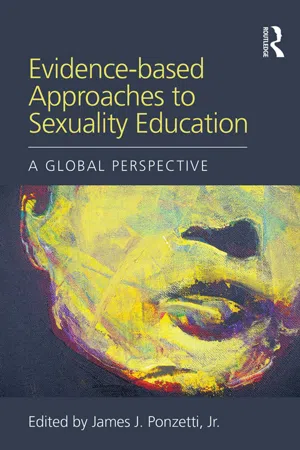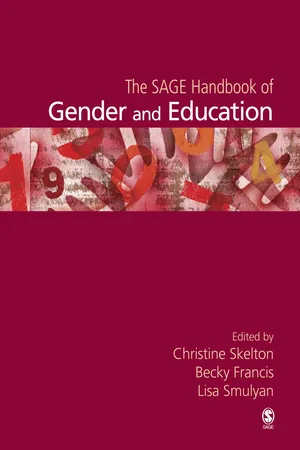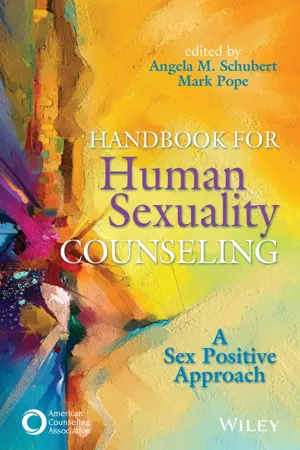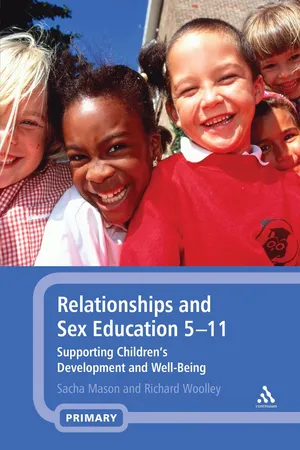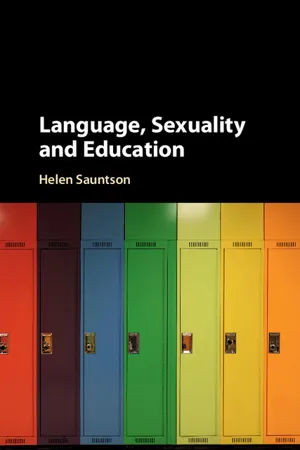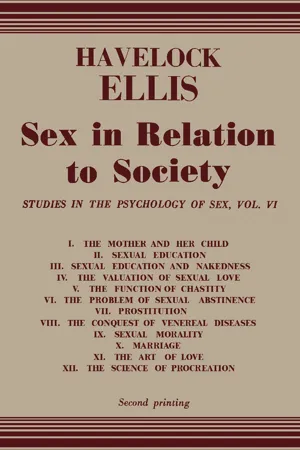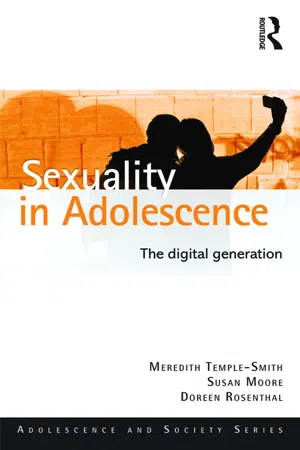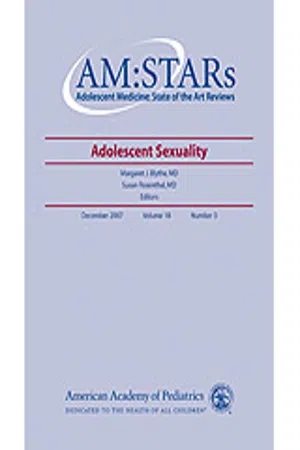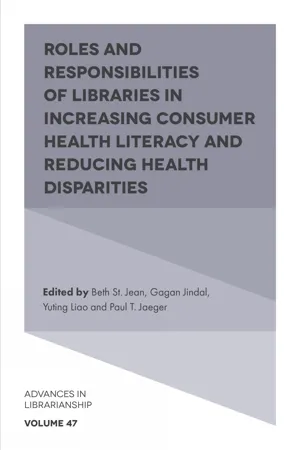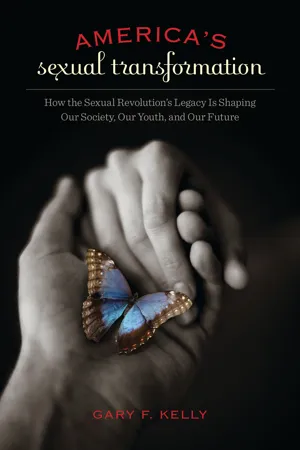Social Sciences
Sex Education
Sex education refers to the process of providing information and guidance on human sexuality, including reproductive health, sexual anatomy, and sexual activity. It aims to promote healthy attitudes and behaviors related to sex and relationships, as well as to prevent negative outcomes such as unintended pregnancies and sexually transmitted infections. Sex education can be delivered through formal school programs, community initiatives, and parental guidance.
Written by Perlego with AI-assistance
Related key terms
1 of 5
12 Key excerpts on "Sex Education"
- eBook - ePub
Evidence-based Approaches to Sexuality Education
A Global Perspective
- James J. Ponzetti, Jr.(Authors)
- 2015(Publication Date)
- Routledge(Publisher)
According to the online Merriam dictionary, Sex Education is simply defined as “education in schools about sex” (Sex Education, Def., N.D.a).The online thesaurus of Macmillan dictionary also defines Sex Education as “information about sex and sexual relationships that adults teach young people, especially in schools” (Sex Education, Def., N.D.b). Furthermore, the Sexuality Information and Education Council of the United States (SIECUS) defines sexuality education as the process of acquiring and forming attitudes and beliefs and skills related to sex, sexuality identity, relationships, and intimacy (SIECUS, 2014). The International Planned Parenthood Federation (IPPF), a non-profit organization that serves 37 sub-Saharan African countries, defines sexuality education as “Education about all matters relating to sexuality and its expression. Sexuality education covers topics such as relationships, attitudes towards sexuality, sexual roles, gender relations, and the social pressures to be sexually active. It also provides information about sexual and reproductive health services and may include training in communication and decision making skills” (IPPF, 2007, p. 58). Moreover, the 2013 United Nations Educational, Scientific and Cultural Organization’s (UNESCO) Young People Today. Time to Act report (UNESCO, 2013), which was developed and supported by countries in the Eastern and Southern African region, describes sexuality education from a comprehensive sexuality education approach that involves teaching and learning on issues relating to human development and sexuality. The primary focus of this approach is to equip children and young people “with knowledge, skills and values to make responsible choices about their sexual and social relationships in a world affected by HIV” (UNESCO, 2013, p. 21) - eBook - PDF
- Christine Skelton, Becky Francis, Lisa Smulyan, Christine Skelton, Becky Francis, Lisa Smulyan(Authors)
- 2006(Publication Date)
- SAGE Publications Ltd(Publisher)
The teaching of Sex Education remains one of the biggest challenges for governments, educational institutions, teachers and policy makers in Sub-Saharan Africa. The word ‘sex’ as used in ordinary language is ambiguous, referring to both the biological category of being male or female and the act of engaging in sexual activities. Sexual activities, behaviors and attitudes to sex are informed by a gender system. Gender is a social construction that ascribes roles, behaviors and attitudes on the basis of sex. A sex/gender system is thus implicated in the marking of biological sex with socially constructed gender meaning of what it means to be a woman or a man. The word ‘sex’ will therefore be used to embrace the whole concept of sexuality. Sexuality is perceived as the social construction of a biological drive (Gupta, 2002), derived and sustained through a hierarchical sex/gender system (Collins, 1990). In this context, Sex Education includes legit-imized knowledge and discourses on sexual behaviors, practices, attitudes and the asymmetrical power relations between boys/men and girls/women that are transmitted through the formal and the informal school curriculum as well as the subsequent resistant discourses that operate in the schools. In view of this broad conceptualization of the meaning of Sex Education, some countries, for instance, New Zealand, have changed the name ‘Sex Education’ in their official curriculum to ‘sexuality education’ (Allen, 2004) while in Britain and the USA, the name ‘Sex Education’ is still predominantly used (Epstein and 18 ‘Sex’ Education: Subjugated Discourses and Adolescents’ Voices B a g e l e C h i l i s a Johnson, 1998; Kehily, 2002; Fine, 2003). In most countries in Sub-Saharan Africa, the preferred name is ‘family life education’ or ‘life skills education’. This chapter maps the theoretical approaches that have been used to explain, analyze and interpret the nature and function of Sex Education. - eBook - ePub
Handbook for Human Sexuality Counseling
A Sex Positive Approach
- Angela M. Schubert, Mark Pope(Authors)
- 2022(Publication Date)
- American Counseling Association(Publisher)
Just as Darwin’s theory of evolution has continually been disputed by believers in creationism, theories regarding sexual development and behavior are constantly being challenged around the world by centuries-old religious beliefs and social mores regarding human sexuality. Science may not care what people believe, but that does not mean everyone will be easily convinced to replace their traditional religious and cultural norms with science-based research findings. Sex educators have a duty to respectfully, but persuasively, present science-based information even when it contradicts students’ existing belief systems.According to Breuner et al. (2016):Sexuality education is defined as teaching about human sexuality, including intimate relationships, human sexual anatomy, sexual reproduction, sexually transmitted infections, sexual activity, sexual orientation, gender identity, abstinence, contraception, and reproductive rights and responsibilities. Developmentally appropriate and evidence-based education about human sexuality and sexual reproduction over time provided by pediatricians, schools, other professionals, and parents is important to help children and adolescents make informed, positive, and safe choices about healthy relationships, responsible sexual activity, and their reproductive health. (para. 1)There are currently two predominant viewpoints on Sex Education available to educators when developing curricula: abstinence only Sex Education (AOSE), which is sometimes referred to in the literature as abstinence only until marriage (AOUM); and comprehensive sexuality education (CSE). A less common approach is termed abstinence plus education - eBook - ePub
Relationships and Sex Education 3–11
Supporting Children’s Development and Well-being
- Sacha Mason, Richard Woolley(Authors)
- 2019(Publication Date)
- Bloomsbury Academic(Publisher)
This chapter locates the current Relationships and Sex Education (RSE) policy in England in an historical context. It discusses the development of Sex Education from the early twentieth century to the present day, with reference to social and cultural influences that have impacted on government policymaking. The notion of relationships and values, both societal and personal, are raised in relation to this controversial and sensitive curriculum area. A pedagogical approach that introduces the concept of ‘bravery’ is also considered.In England, Sex Education has been a long-established term for the teaching and learning of the biological aspects of human reproduction. It is only relatively recently (2000) that the inclusion of ‘Relationship’ in the title of government documentation has been made and very recently that ‘Relationships’ in the plural has been used (2018). The separation of relationships from sex is a complex process. It is, therefore, challenging for adults, in and out of the school context, when discussing the biology of sex with children and young people to not talk about or to set aside the dynamics of emotions, desire and intimacy in relationships.The concept of Sex Education The concept of Sex Education is defined by Wyness (1996: 98) asthe deliberate and intentional handling of knowledge about sexual matters.This definition fails to acknowledge the links within a value’s framework. As Halstead and Reiss (2003: 3) argue, values ‘permeate every aspect of Sex Education in schools’. This claim makes clear that the transmission of values may, or may not, be conscious on the part of the teacher, in that the formal education system, and not exclusively RSE, is the overt and covert transmission of a value system. Therefore, no educational engagement or teacher–student relationship, whatever the subject content, can be value-free. This extends to informal educational settings where children and young people are exposed to a value’s framework, and this may, or may not, present different values to those within formal education. Children can experience a range of differing value systems with each attributed to the varied aspects of their lives: home, school and out-of-school. These values may be mixed, sometimes contrasting with those from other families through their peer groups and the wider community. It can be argued, however, that the value system that is transmitted through the school curriculum represents the most prominent influence on societal values with increasing central governmental control through the introduction of a National Curriculum by the Conservative government in 1989 and the continued agenda of centralization by subsequent governments, which is explored further in the chapter. Marxist theorists such as Althusser (cited in Barry, 2002: 164) claim that in an increasingly secular world where previous ‘ideologies’ were derived from religion, the power of the state has been extended and evolved through formal education. Education through compulsory schooling is a powerful social tool that establishes the framework to which society adheres – an ‘ideological state apparatus’. - eBook - PDF
Relationships and Sex Education 5-11
Supporting Children's Development and Well-Being
- Sacha Mason, Richard Woolley(Authors)
- 2011(Publication Date)
- Continuum(Publisher)
22 Relationships and Sex Education 5–11 Introduction This chapter locates the current SRE policy in England in a historical context. It discusses the development of Sex Education from the early twentieth century up until the present day, with reference to social and cultural influ-ences that have impacted upon government policy-making. The notion of relationships and values, both societal and personal, are raised in relation to this controversial and sensitive curriculum area. A pedagogical approach that introduces the concept of ‘bravery’ is also considered. In England, Sex Education has been a long-established term for teaching and learning about the biological aspects of human reproduction. It is only relatively recently (2000) that the inclusion of ‘Relationship’ in the title of government documentation has been made. The separation of relationships from sex is a complex process and while exploring the biology of sex with children and young people may appear to simplify issues, the interrelationship of emotions and intimacy with sexual intercourse and other physical expression raises many challenges for those professionals managing such curricula. The concept of Sex Education The concept of Sex Education is defined by Wyness (1996, p. 98) as: ‘the deliberate and intentional handling of knowledge about sexual matters’. This definition fails to acknowledge the links within a values framework. As Halstead and Reiss (2003, p. 3) argue, values ‘permeate every aspect of Sex Education in schools’. This claim makes clear that the transmission of values may, or may not, be conscious on the part of the teacher, in that the formal education system, and not exclusively SRE, is the overt and covert trans-mission of a value system. Therefore, no educational engagement or teacher/ learner relationship, whatever the subject content, can be value-free. - eBook - PDF
- Helen Sauntson(Author)
- 2018(Publication Date)
- Cambridge University Press(Publisher)
1 Confronting the Context As indicated in the Introduction, sexuality is a timely and important issue for education. As a topic within education, sexuality has largely been focused on in terms of Sex Education provision both in the United States and United Kingdom. Until recently, little attention has been paid to the social dimen- sions of sexuality and its relationship with issues of identity. Even now, it is only the work of LGBT+ rights organizations such as Stonewall in the United Kingdom and GLSEN (Gay, Lesbian and Straight Education Network) in the United States who are focusing on the social identity issues surrounding sexuality and its treatment within schools. In this chapter, I briefly outline how Sex Education has historically and politically been approached in UK and US education systems. I then discuss recent and current work on sexual identity issues in schools, with a particular focus upon key issues surround- ing LGBT+ identities. In Chapter 2, I provide reviews of literature in the fields of sexuality and education, and language and sexuality. The reviews of literature are followed by an explanation of the theoretical and analytical framework – queer applied linguistics – which informs the research presented in this book. Finally, I describe the research design and provide short summaries of the content of each of the data analysis chapters. Sex and Relationships Education (SRE) History, Politics and Policy In both the United States and the United Kingdom, little attention was paid to Sex Education in schools until the work of Kinsey was published throughout the 1950s and the sexual revolution of the 1960s. Past and current debates in both countries have focused on whether or not Sex Education should be compulsory in schools and, in the US, there have been (and continue to be) widespread discussions about what have come to be termed ‘comprehensive’ and ‘abstinence-only’ approaches to Sex Education. - eBook - PDF
Sex in Relation to Society
Studies in The Psychology of Sex, Vol. 6
- Havelock Ellis(Author)
- 2013(Publication Date)
- Butterworth-Heinemann(Publisher)
It is in the United States, however, that the most comprehensive and thorough attention has been given to this matter. The earlier efforts were unsatisfactory, if not mischievous, largely made up of warnings and goody-goody advice, with emphasis on the awful risks of venereal disease. But they prepared the way for a more constructive Sex Education. In 1920 the American Social Hygiene Association took up the work and enlarged its scope to cover all fields. In this way the attention of college authorities became focused on their responsibilities in the matter and considerable experimentation SEXUAL EDUCATION 49 resulted. In 1 9 2 4 the Association proposed to the Presidents of colleges a joint study of the whole problem in order to work out the best methods, and upwards of 2 0 0 universities and colleges appointed committees to co-operate. The subjects explored for integration in this study included biology,, psychology, sociology, physiology and hygiene, education, physical education, home economics. 1 Since then there has been steady progress, as also in the high schools where the subjects of sex are being gradually integrated in the curriculum, and all special " emergency " sex lectures superseded. It is becoming more and more clearly realized that the pioneers in this field who wished to introduce a new and isolated study of " sex " were on the wrong track. Sex enters into all fields of life, and the right way to approach it is not to separate it off for independent study, but to recognize it and give it due weight in every field where it naturally occurs. We do not want specially trained teachers of " sex " in our schools. We need all teachers to be so well trained in their own special subjects that they are able to face and discuss the sexual aspects of these subjects whenever they properly appear. This central point in " Sex Education " might well be emphasized. This aspect of life will become more and more firmly integrated in school curricula. - eBook - ePub
Sexuality in Adolescence
The digital generation
- Meredith Temple-Smith, Susan Moore, Doreen Rosenthal(Authors)
- 2015(Publication Date)
- Routledge(Publisher)
5Sex Education, religion and the law The teachers were very, very good teachers, they taught me a lot of things I didn’t know, they were AWESOME!THE SOCIAL CONTEXT(Smith, Realini, Buzi & Martinez, 2011:270)You have Sex Ed in high school. So you learn a bit from there, but I can’t really remember anything they taught us.(Ewert, Collyer & Temple-Smith, under review)We have seen in the previous chapter how parents and peers influence young people in their sexual decision-making. We turn now to some of the other factors that contribute to young people’s sexual knowledge, practice and attitudes. Where available, Sex Education programmes conducted in schools are an important formal source of information, but there are also factors that limit adolescents’ sexual attitudes and choices. So while adolescents are learning about sexual behaviour from a variety of sources, their views are also shaped by the religious and cultural values and the legal constraints imposed upon them by their society. In this chapter, we consider these more distal influences of school, religion and the law on adolescent sexuality. A particular focus is on Sex Education, its goals, forms and effectiveness.School-based Sex EducationDespite the fact that the availability and quality of school-based education varies widely across the globe, school still provides an important opportunity for delivering Sex Education. Schools are institutions regularly attended by young people and able to reach most adolescents. If Sex Education is implemented early enough, young people from diverse social backgrounds and with diverse needs can be reached, often before sexual activity has begun. With adequate resources and trusted personnel available to convey information to young people and to facilitate discussion, schools can provide ‘a practical means of reaching large numbers of young people in ways that are replicable and sustainable’ (Kirby, 2011:1), and potentially assessable in terms of impact. Importantly, the majority of young people and their parents support the idea of school-based education about sex and sexual health (Giordano & Ross, 2012; McKay & Bissell, 2010; Sherbet Research, 2009). - eBook - PDF
AM:STARs Adolescent Sexuality
Adolescent Medicine: State of the Art Reviews, Vol. 18, No. 3
- American Academy of Pediatrics Section on Adolescent Health, Margaret J. Blythe, Susan L. Rossenthal, Margaret J. Blythe, Susan L. Rossenthal(Authors)
- 2007(Publication Date)
- American Academy of Pediatrics(Publisher)
Approaches to Adolescent Sexuality Education Mary A. Ott, MD* a , John S. Santelli, MD, MPH b a Section of Adolescent Medicine, Department of Pediatrics, Indiana University School of Medicine, 410 West 10th Street, HS1001, Indianapolis, IN 46202, USA b Heilbrunn Department of Population and Family Health, Mailman School of Public Health, Columbia University, 60 Haven Avenue, New York, NY 10032, USA Developing a healthy sexuality is a key developmental task for adolescents. Healthy sexuality includes, “sexual development, reproductive health, and such characteristics as the ability to develop and maintain meaningful interpersonal relationships, appreciate one’s own body; interact with both genders in respectful and appropriate ways; and express affection, love, and intimacy in ways consis-tent with one’s own values.” 1 In recent years, adolescent sexuality has moved from being an issue of the health and well-being of adolescents to being a politically volatile and divisive topic. Nowhere is this shift more relevant to adolescent health and well-being than in the area of sexuality education. The purpose of this article is to provide back-ground on adolescent sexual behavior, to review the current sexuality education policy landscape, to examine data that support different educational approaches, and to discuss specific concerns with federal support of abstinence-only educa-tion. SEXUAL AND REPRODUCTIVE BEHAVIOR Sexuality is a normal part of development. It becomes a public health concern when sexual behavior poses a health risk to oneself or others (eg, through unintended pregnancy or sexually transmitted infections [STIs]). This stands in contrast to other adolescent health risk behaviors and/or conditions such use of tobacco and obesity, which are unhealthy under any circumstances. - Beth St. Jean, Gagan Jindal, Yuting Liao, Paul T. Jaeger, Beth St. Jean, Gagan Jindal, Yuting Liao, Paul T. Jaeger(Authors)
- 2020(Publication Date)
- Emerald Publishing Limited(Publisher)
CHAPTER 9
SEXUAL EDUCATION IS A HUMAN RIGHT: INFORMATION INEQUITIES OF K-12 SEXUAL EDUCATION AND LIBRARIANS’ ROLES IN SUPPORTING ADOLESCENTS’ SEXUAL HEALTH LITERACY
Karina KletscherABSTRACT
American Sex Education is continually under fire due to conflicting morals surrounding hegemonic sociocultural norms. These programs, and ultimately the students, are often victims of information inequities which leverage adult control over minors to prevent access to sexual health information. Withholding salient sexual health information infringes on intertwined tenets of human rights, such as education and information access. Spurred by recent disputes and barriers to updating unethical curricula in the states of Arizona and Texas, this chapter uses a human rights lens to explore the current information inequities in K-12 sexual education and students’ precarious positions in policy spaces. This framework demonstrates how libraries are uniquely protected spaces for intellectual freedom and the roles librarians can and should play as sexual health information providers in order to help students overcome information inequities. This chapter will provide recommendations for librarians and other educators to inform and organize advocacy as well as leverage current library operations to support adolescents’ sexual health literacy.Keywords: Sexual education; human rights; youth rights; information access; sexual health literacy; librariesINTRODUCTION
Comprehensive sexual education (CSE) is foundational to functioning safely and healthily in a highly commercialized, consumption-oriented world (Magi & Garnar, 2015 ; Moore & Reynolds, 2018 ; Robinson, 2012 ). This curriculum is meant to explore and fill students’ information gaps, provide safe places for their learning and growth, and help them to develop sexual health literacy (SHL) (Kantor & Lindberg, 2020 ). For many American students, the only formal education and preparation for emerging into their sexuality and the complexities of twenty-first century life are Abstinence-Only-Until-Marriage or, recently rebranded, Sexual Risk Avoidance programs (Boyer, 2018 ). These programs exclusively focus on abstinence from sexual activity by stigmatizing sexuality, particularly non-heteronormativity, and withhold health information salient to adolescents’ SHL and development (Boyer, 2018 ; Guttmacher Institute, 2017 ; Kantor & Lindberg, 2020 ; Santelli et al., 2017 ). These information barriers are not only unethical, but go against basic human rights to education and information access (Santelli et al., 2017 ; United Nations (UN), 1948 , 1989- eBook - PDF
America's Sexual Transformation
How the Sexual Revolution's Legacy Is Shaping Our Society, Our Youth, and Our Future
- Gary F. Kelly(Author)
- 2011(Publication Date)
- Praeger(Publisher)
It was an introduction that perhaps explained some of the ambiguity he always held regarding sexual topics. Such uncertainty and em- barrassment about sexuality were pretty much de rigueur for his generation. Although attempts to “normalize” Sex Education limped along, the training of educators was practically nonexistent. The American Social Hygiene Associa- tion said in the 1930s that sex educators should be of “good character” and “well versed” in their subject matter and recommended that those who were “embarrassed, abnormal, unhappily married, or pessimistic” should not be al- lowed to be sex educators. 4 One can only wonder how such qualities of life and personality were to be assessed. During the decades of the 1940s, 1950s, and 1960s, there was increasing interest in providing Sex Education for young people, bolstered by the very same social developments and scientific studies that were fueling the emerg- ing sexual revolution. There was also a gradual shift away from moralizing 88 AMERICA’S SEXUAL TRANSFORMATION to students and toward the provision of scientifically supportable facts. The American Medical Association collaborated with the National Education Association to produce five pamphlets about the sexuality of young adults that were widely distributed. Professionals who had long touted sexual top- ics mostly within the context of marriage began to rethink that position and adopt a depathologized perspective that put an emphasis on the positive ways in which sexuality could be integrated into the human experience. The impor- tant thing was to deal with values as well as substantive content. 5 In contrast to this significant philosophical shift was the typical pattern for instituting Sex Education programs in schools. Most often some teachers, parents, and board of education members would become alarmed by a flurry of teen pregnancies and decide that Sex Education was needed to stem this regrettable tide. - eBook - PDF
Teaching Sex
The Shaping of Adolescence in the 20th Century
- Jeffrey P. Moran(Author)
- 2009(Publication Date)
- Harvard University Press(Publisher)
25 Fourteen percent of all social stud-ies courses dealt at some point in the school year with these and other aspects of sexual relations. Such ~gures cheered the proponents of inte-grated Sex Education. The total statistics give a clearer picture of Sex Education’s content. Of 1,665 schools Usilton and Edson found teaching integrated Sex Education in 1927, 1,306 taught something about “eugenics and heredity,” 1,154 about reproduction, 850 about “social aspects” of sexuality, 571 about ve-106 T E A C H I N G S E X nereal diseases, and approximately 420 about “internal secretions” and menstruation. Finally, 171 schools claimed to include material on seminal emissions in one course or another. 26 Some investigators perceived gaps in the integrated approach. Fewer than 4 percent of courses on general science and home economics touched on sex. Schools were underutilizing these offerings, maintained Edson and Usilton, for such courses were usually given in the ~rst year of high school, “which is the most propitious time for clearing the confusion and dispelling the dis-torted ideas of youth.” 27 And though the researchers followed the educa-tional path laid out by Bigelow and Gruenberg, they unfortunately did not seek information on the extent to which Sex Education was taught in the Eng-lish classrooms. In general, sex was appearing far more often in the regular curriculum, but its surfacings were as sporadic as one would expect for a subject whose implementation was largely informal and uncoordinated. The prevalence of integrated teaching depended to some extent on the size of the school, the authors found. Large schools, with enrollments of more than ~ve hundred students, were more likely to offer Sex Education in the ~rst place, and their lessons on sex were signi~cantly more likely to be integrated into the curriculum.
Index pages curate the most relevant extracts from our library of academic textbooks. They’ve been created using an in-house natural language model (NLM), each adding context and meaning to key research topics.
